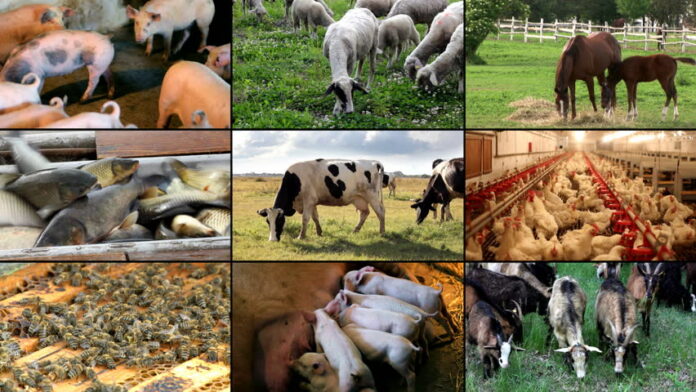Livestock farming involves the rearing of animals for food and other human uses. They can be leather, wool and fertilizer production. This type of farming primarily applies to cattle or dairy cows, chickens, goats, pigs, horses and sheep. However, it is also increasingly relevant for other animals such as donkeys, mules, rabbits and insects. These insects can be bees which are now being raised as part of livestock farming.
Livestock farming has been a part of human society for most of history. It started ever since humans started domesticating animals to make their life better. But as with most forms of farming, such as agriculture, livestock farming too has intensified. The process has occurred particularly in recent decades.
This has allowed the goods of livestock farming to become more widely available and cheaper to buy; which is particularly important if you think that staples such as milk, honey, eggs and meat are all products on livestock farming. However, the practices of intensive livestock farming have had on several occasions given a lot of concern in terms of food safety, animal welfare and environmental impacts. Here is a look at advantages and disadvantages that comes with this type of farming
Advantages of intensive livestock farming
At face value, it is hard to discount the importance of this industry. The direct contributions of livestock farming to the economy is currently at a high percentage. However, this does not account for the services that rely on it. These services range from butchers, retailers, transport companies to feed producers and equipment manufacturers. Beyond its economic value, livestock farming supports the livelihoods and provides food security to most of the country’s population.
Today, it is one of the fastest growing sectors of the agricultural economy. This has been made possible through the increasing intensification of livestock farming practices. In addition, they have helped increase yields and efficiency while bringing down costs. For example, the practice of concentrated animal feeding operation, means farmers can rear more animals by confining them in concentrated areas. This method maximizes the potential of the land area they have at their disposal. In other words, pigs, cows, chickens, and other livestock are kept in a very small area of land. Through it, livestock are made easier to manage while increasing output for a smaller amount of land.
Disadvantages of intensive livestock farming
At the same time, we cannot discount the increasing animal welfare, environmental and health concerns that the intensification of livestock farming brings. When it comes to animal welfare, cost saving techniques often have an impact on the health and wellbeing of the animals. Legislation in many countries including ours recognizes animals as “sensitive beings” and not merely commodities which means that they can experience emotions, including pain and distress. This means that it is not accepted that animals reared as livestock should live under active conditions. Unfortunately, practices where animals are transported long distances to market under inhuman conditions or slaughtered in painful ways still persist.
At the same time, the often very crowded conditions under which livestock animals are kept in intensive farming, means that the animals are more susceptible to diseases. In low- and middle-income nations. Furthermore, there are livestock-related diseases that can affect humans beings. In an effort to ensure animals do not contract diseases, some farmers use antibiotics which in the long-term lead to the evolution of bacteria and the rise of drug-resistant pathogens.
Environmental problems of intensive livestock farming
In terms of the environment, it is fairly well-known that livestock sector accounts for some percentage rate in human-induced greenhouse-gas emissions. Moreover, animal waste and discards is often not treated appropriately with farmers often disposing their waste in rivers where they pollute the water and threaten the ecosystem’s biodiversity.
While there are clear challenges to intensive livestock farming, there will always be the need to address food security.









this😎
is a nice business💯
and I love it so much🙏
it is a complement
Is a good idea
thank you